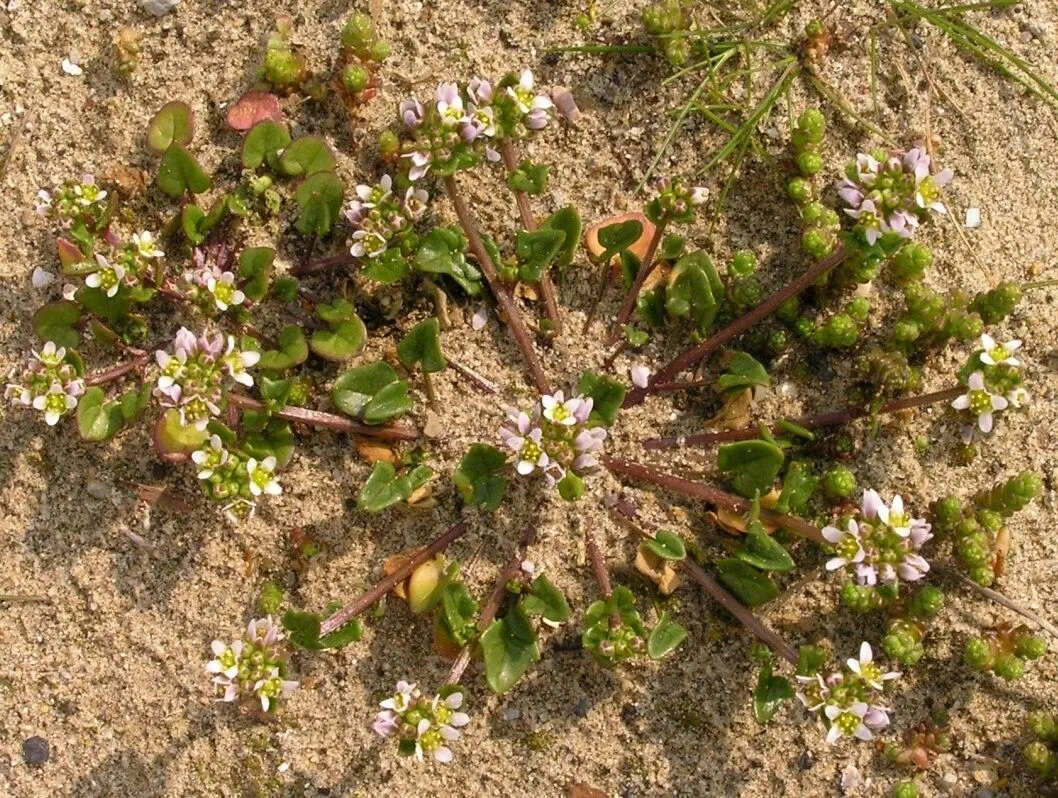
Author: L.
Bibliography: Sp. Pl.: 647 (1753)
Year: 1753
Status: accepted
Rank: species
Genus: Cochlearia
Vegetable: False
Observations: Coastal W. & N. Europe
Danish scurvy grass, scientifically known as Cochlearia danica, is a flowering plant belonging to the family Brassicaceae. This plant was first described in the seminal botanical work “Species Plantarum” by Carl Linnaeus (referred to simply as ‘L.’) in the year 1753.
Danish scurvy grass is predominantly found along the coastal regions of Western and Northern Europe. It thrives in the saline environments of these areas, often seen flourishing in rocky sea cliffs, salt marshes, and dunes. Its ability to prosper in coastal zones is attributed to its salt tolerance, making it a resilient species in challenging environments.
The plant itself is relatively small, characterized by its fleshy, spoon-shaped leaves and delicate white flowers, which bloom in clusters. These features are not merely aesthetic; the fleshy leaves help the plant retain moisture, a crucial adaptation for surviving in salty, wind-swept locales. The flowers of Cochlearia danica typically appear from early spring to mid-summer, contributing to the plant’s propagation and the overall biodiversity of its habitat.
Historically, Danish scurvy grass has played a notable role due to its high vitamin C content. During the era of prolonged sea voyages, sailors would consume its leaves to prevent scurvy, a potentially fatal disease caused by vitamin C deficiency. This historical use is reflected in the plant’s common name.
In addition to its historical significance, Cochlearia danica is of interest to botanists and environmental scientists who study coastal ecosystems and plant adaptation mechanisms. The plant’s presence is often an indicator of saline soil environments, providing clues about soil health and salinity levels.
Overall, Danish scurvy grass is an intriguing plant not only for its distinctive botanical characteristics but also for its contribution to historical health practices and its role in sustaining coastal biodiversity.
Dan: dansk kokleare
Deu: dänisches löffelkraut
Fra: cochléaire danoise
Nob: dansk skjørbuksurt
Nno: dansk skjørbuksurt
Swe: dansk skörbjuggsört, tanskankuirimo
Nld: deens lepelblad
Eng: early scurvygrass, danish scurvygrass, early scurvy-grass
Nor: erics-gras, erts-gras
Fin: tanskankuirimo
Cym: llwylys denmarc, llwylys llychlyn, morlwyau danaidd, morlwyau eiddewddail, morlwyau glan môr, ysgyifi-lys llychlyn
Gla: carrán creige
En: Danish Scurvy Grass, Danish scurvygrass, Danish Spoonwort, Early Scurvy-grass, Early scurvygrass, Danish Scurvy-grass
Kw: Kraghles danek
Da: Dansk Kokleare
Nl: Deens lepelblad
Et: Taani merisalat
Fi: Tanskankuirimo
Fr: Cochléaire danoise, Cochléaire du Danemark, Cranson du Danemark
De: Dänisches Löffelkraut, Early Scurvy Grass
No: Erics-gras, Erts-gras
Nb: Dansk skjørbuksurt
Nn: Dansk skjørbuksurt
Fa: کچلریا دانیکا
Pl: Warzucha duńska
Gd: Carrán creige
Sv: Dansk skörbjuggsört, Tanskankuirimo
Cy: Llwylys Denmarc, Llwylys Llychlyn, Morlwyau Danaidd, Morlwyau Eiddewddail, Morlwyau Glan Môr, Ysgyifi-Lys Llychlyn
: Danish scurvy grass
Taken Mar 7, 2022 by Pierre LEON (cc-by-sa)
Taken Feb 7, 2022 by Pierre LEON (cc-by-sa)
Taken Mar 26, 2021 by Rinusz (cc-by-sa)
Taken Mar 26, 2021 by Rinusz (cc-by-sa)
Taken Mar 14, 2022 by Pierre LEON (cc-by-sa)
Taken Feb 7, 2022 by Pierre LEON (cc-by-sa)
Taken Mar 23, 2022 by Pierre LEON (cc-by-sa)
Taken Mar 7, 2022 by Pierre LEON (cc-by-sa)
Taken Mar 26, 2021 by Rinusz (cc-by-sa)
Taken Mar 14, 2022 by Pierre LEON (cc-by-sa)
Taken Mar 1, 2022 by Pierre LEON (cc-by-sa)
Taken Mar 23, 2022 by Pierre LEON (cc-by-sa)
Taken Feb 23, 2021 by Maryse M (cc-by-sa)
Taken Mar 7, 2022 by Pierre LEON (cc-by-sa)
Taken Mar 14, 2022 by Pierre LEON (cc-by-sa)
Taken Mar 3, 2022 by Pierre LEON (cc-by-sa)
Taken Mar 8, 2022 by Pierre LEON (cc-by-sa)
Taken Mar 23, 2022 by Pierre LEON (cc-by-sa)
Taken Mar 1, 2022 by Pierre LEON (cc-by-sa)
Taken Mar 7, 2022 by Pierre LEON (cc-by-sa)
Taken May 10, 2003 by Tela Botanica − Liliane ROUBAUDI (cc-by-sa)
Taken May 25, 2021 by Paul Henrich (cc-by-sa)
Taken Apr 18, 2022 by Tristan Jaton-Maria (cc-by-sa)
Taken Apr 18, 2022 by Tristan Jaton-Maria (cc-by-sa)
Taken May 10, 2003 by Tela Botanica − Liliane ROUBAUDI (cc-by-sa)
Taken Mar 19, 2012 by Tela Botanica − Liliane Roubaudi (cc-by-sa)
Taken Mar 17, 2013 by Tela Botanica − Liliane Roubaudi (cc-by-sa)
Taken Mar 17, 2013 by Tela Botanica − Liliane Roubaudi (cc-by-sa)
Taken May 9, 2014 by Tela Botanica − Françoise CARLE (cc-by-sa)
Taken Mar 23, 2021 by Vincent Guillot (cc-by-sa)
© copyright of the Board of Trustees of the Royal Botanic Gardens, Kew.
© copyright of the Board of Trustees of the Royal Botanic Gardens, Kew.
© copyright of the Board of Trustees of the Royal Botanic Gardens, Kew.
Ph maximum: 7.5
Ph minimum: 7.0
Light: 8
Atmospheric humidity: 6
Bloom months: [‘feb’, ‘mar’, ‘apr’, ‘may’]
Soil nutriments: 5
Soil salinity: 5
Family: Myrtaceae Author: (F.Muell.) K.D.Hill & L.A.S.Johnson Bibliography: Telopea 6: 402 (1995) Year: 1995 Status:…
Family: Rubiaceae Author: Pierre ex A.Froehner Bibliography: Notizbl. Bot. Gart. Berlin-Dahlem 1: 237 (1897) Year:…
Family: Sapindaceae Author: Koidz. Bibliography: J. Coll. Sci. Imp. Univ. Tokyo 32(1): 38 (1911) Year:…
Family: Asteraceae Author: A.Gray Bibliography: Pacif. Railr. Rep.: 107 (1857) Year: 1857 Status: accepted Rank:…
Family: Fabaceae Author: Medik. Bibliography: Vorles. Churpfälz. Phys.-Ökon. Ges. 2: 398 (1787) Year: 1787 Status:…
Family: Aspleniaceae Author: (Cav.) Alston Bibliography: Bull. Misc. Inform. Kew 1932: 309 (1932) Year: 1932…